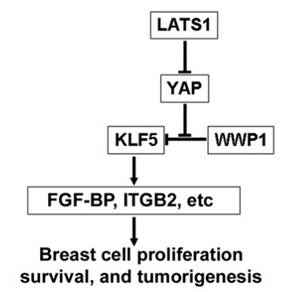
Research over the past decade has implicated over-expression of the Yes-associated protein (YAP) in the development of breast cancer. Despite strong experimental correlation between these and the proliferation, survival and migration of breast cancer cells, how YAP promotes cancer development was unclear until CHEN Ceshi’s group at the Kunming Institute of Zoology, Chinese Academy of Sciences (KIZ, CAS) recently discovered that the link between YAP and cancer may be caused by YAP’s interaction with another protein, Krüppel-like factor 5 (KLF5).
Earlier research indicated that YAP seems affect the Hippo tumor suppressor pathway by regulating gene expression connected with the formation of tumors. Although YAP partially functions by binding to the TEAD transcription factors, YAP uses the WW domains to bind with several PY motif-containing transcription factors that are essential in regulating gene expressions that stimulate the growth and oncogenic transformation. However, YAP’s key proproliferate and prosurvival partner transcription factor had not been determined until CHEN’s group identified KLF5 as a potential candidate.
Expression levels of both KLF5 and YAP in different types of cancers suggests more than a passing relationship. Most malignant breast cancers are estrogen receptor-negative (ERα-), meaning their growth is not driven by estrogen. In these types of cancers, both YAP and KLF5 are coexpressed, and high levels of KLF5 mRNA often coincide with smaller and shorter survival rates for cancer patients. However in estrogen receptor positive breast cancers (ERα+) this is not the case. Earlier studies have shown low expression of KLF5 in these lines and CHEN’s team noted that YAP showed similar expression levels. To further test this relationship, CHEN’s group provided a proof-of-concept by knocking down both YAP and KLF5 in SW527 cells, which resulted in significantly reduced tumor growth and decreased cell proliferation.
The findings on the relationship between YAP and KLF5 led to further questions because there have been no previously known mechanisms to regulate KLF5 at the protein post-translational level. Surprisingly, YAP was shown to stabilize KLF5 and increase its activities of inducing target gene expression and promoting breast cell growth and survival. YAP functions partially through binding to KLF5 and interactions with the KLF5 PY motif through its WW domains, preventing the E3 ubiquitin ligase WWP1 from ubiquitinating KLF5.
CHEN’s team’s findings seem to indicate that KLF5 could be an important transcription factor partner for YAP and may contribute to the Hippo pathway. More importantly, these results suggest that inhibiting the expression of YAP and KLF5 could decrease ERα-negative breast cell growth in in vivo studies, indicating they may provide new targets for breast cancer treatment. Detailed analyses of these findings are being published in “YAP Promotes Breast Cell Proliferation and Survival Partially through Stabilizing the KLF5 Transcription Factor” in the American Journal of Pathology 180(6): http://dx.doi.org/10.1016/j.ajpath.2012.02.025
This work was supported by the Natural Science Foundation of China-Yunnan Province, the Scientific and Technological Program of Yunnan Province and the One Hundred Person Project of the Chinese Academy of Sciences.
